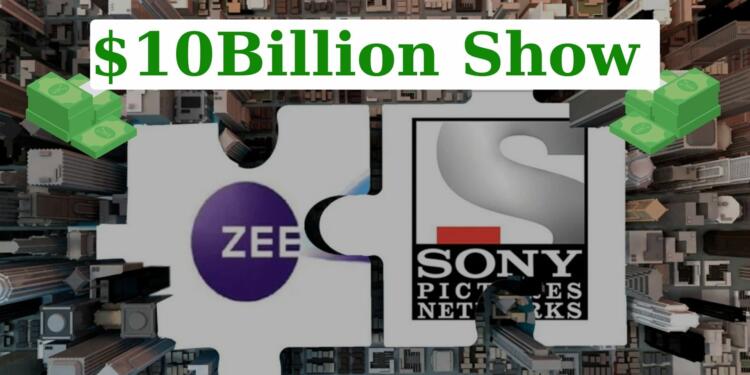In a captivating turn of the whole Zee-Sony diorama, Zee Entertainment (ZEEL) and Sony Group Corporation have reignited discussions to salvage their monumental $10 billion merger, which had been shelved two years ago. Representatives from both entities have convened in Mumbai, fervently aiming to surmount lingering differences and strike a deal within the next 48 hours. The ambiance in the financial arena was notably optimistic as ZEEL stocks surged, trading in the green with a notable 3.67 percent increase at ₹185.20 on February 20th, 10:19 am, on the Bombay Stock Exchange (BSE).
The $300 Million Conundrum
However, the path to reconciliation is sprinkled with obstacles, primarily revolving around a pivotal $300 million write-off concerning cricket rights. Sony’s preference for an upfront settlement contrasts starkly with Zee’s inclination toward a deferred resolution. Furthermore, the battleground extends to leadership dynamics, with reports indicating Punit Goenka, Zee’s CEO, considering stepping down from his helm in exchange for an advisory role. Sony, however, seems steadfast in its stance to maintain Goenka outside the core operational structure. Adding an extra layer of complexity, Zee is adamant about ensuring the irrevocability of any agreement, a proposition met with apprehension from Sony, given the volatile nature of financial landscapes.
With the countdown ticking, both conglomerates find themselves at a critical juncture. Despite Zee’s buoyancy buoyed by recent earnings surges, the potential merger dissolution looms large. Yet, should the deal materialize, it promises to unlock synergies, fortify digital outreach, and forge a formidable presence within the Indian media panorama.
Impending Deadline and Consequences
Nevertheless, the clock ticks relentlessly, underscoring the urgency to bridge the chasm of disparities. Failure to do so risks Sony withdrawing from the negotiation table, leaving Zee to chart its course unaided. Yet, a reconciliation, while desirable, is not devoid of complexities. Legal entanglements initiated by both factions would necessitate disentanglement, further complicating an already intricate puzzle.
Legal recourse has been sought through platforms such as the Singapore International Arbitration Centre (SIAC) and the National Company Law Tribunal (NCLT). Zee, represented by Mad Man Film Ventures, has implored NCLT’s intervention to enforce the merger, while Sony’s Indian subsidiaries have retaliated by questioning the legitimacy of Zee’s application and seeking to forestall implementation. Additionally, Sony has sought emergency interim relief from SIAC against Zee, an entreaty that was subsequently denied.
Sony’s Optimism and Strategic Outlook
Hiroki Totoki, President, COO & CFO of Sony, remains optimistic about the conglomerate’s future endeavors in India. In a recent earnings call on February 14th, he underscored Sony’s enduring commitment to the Indian market, notwithstanding the termination of the proposed merger with Zee. Totoki emphasized Sony’s intent to explore alternative growth avenues in India, leveraging its existing operational framework through Culver Max Entertainment (formerly Sony Pictures Network India).
Addressing concerns regarding the erstwhile investment earmarked for the merger, Totoki reassured stakeholders that the company’s capital allocation and investment strategies remain unaltered. Concrete plans, however, are yet to materialize.
Legal Wranglings and Historical Context
The legal labyrinth deepens as Sony terminated the agreement with Zee Entertainment Enterprises (ZEEL) last month, thereby commencing arbitration proceedings before the Singapore International Arbitration Center (SIAC), claiming a termination fee of $90 million. ZEEL, in a countermove, petitioned the National Company Law Tribunal (NCLT) to compel Sony Group to implement the merger scheme.
On February 4th, SIAC rejected Sony Group’s interim plea to restrain ZEEL from seeking redressal through NCLT. The NCLT had initially greenlit the merger scheme on August 10, 2023, a move that could have birthed a $10 billion media behemoth. This combined entity would have wielded dominion over 70 TV channels, two video streaming platforms (ZEE5 and Sony LIV), and two film studios (Zee Studios and Sony Pictures Films India), thereby emerging as the preeminent entertainment network in the country.
Conclusion
As negotiations teeter on the precipice, the fate of this potentially monumental merger hangs in the balance. Both Zee Entertainment and Sony Group find themselves ensnared in a complex web of financial intricacies and legal entanglements. While the prospects of a reconciliation offer promise, the road ahead is fraught with challenges. Only time will tell whether these corporate titans can transcend their differences and script a new chapter in India’s media landscape.
Also Read: Modi-fied Uttar Pradesh: A Journey Through Innovation and Ingenuity































